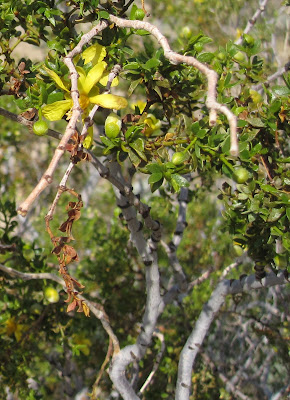Creosote bush, also known as greasewood (Larrea tridentata)
is found in all four southwestern deserts, from southern Nevada, extreme southwestern Utah, southeastern California, the southern one-third of Arizona, southern New Mexico, into west Texas and south into Mexico. The one above was in Organ Pipe Cactus National Monument and the one below was found near Hayfield Rd. off the I-10 freeway just south of Joshua Tree National Park.It usually is found in open, species-poor land, but it also is a transitional species in desert grasslands, mesquite woodlands, Joshua tree communities and desert washes. It flowers from February to August
with yellow, twisted petals.
After the flower blooms,
it turns into a small white fuzzy fruit capsule that has five seeds.
The seed capsules can be found on the ground under the bush.
It is one of the most characteristic features of the the hot southwestern desert. It tolerates arid conditions and it competes aggressivley with other plants for water. It has stems projecting from a base. It is usually less than four feet high, but can get as high as twelve feet when it has lots of water.
The yellow-green leaves conserve water and dissipate heat.
It may lose some of the leaves in extreme drought, but never loses all of them. It is an important source to wildlife. Reptiles and amphibians use it as a food source and perch site and hide and hibernate in burrows under it. Desert tortoises dig their shelters under it where its roots stabilize the soil.










No comments:
Post a Comment